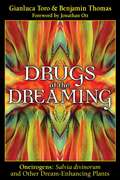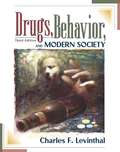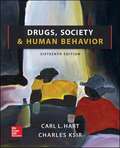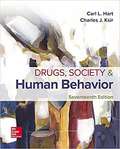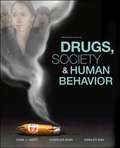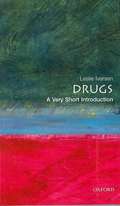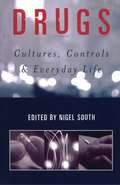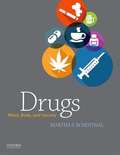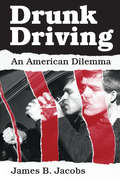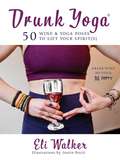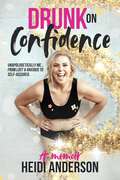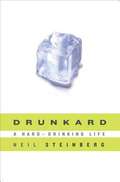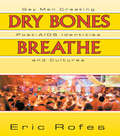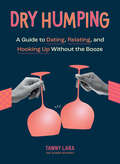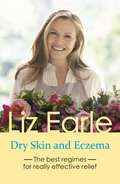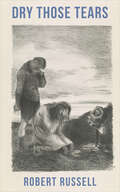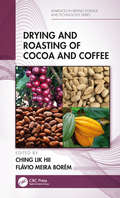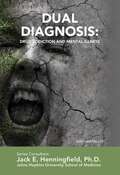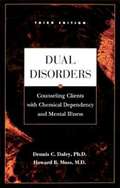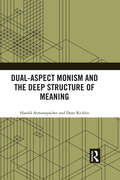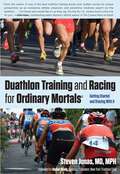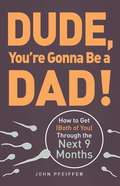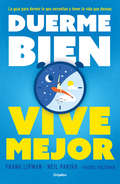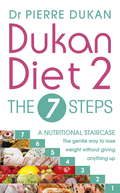- Table View
- List View
Drugs of the Dreaming: Salvia divinorum and Other Dream-Enhancing Plants
by Benjamin Thomas Gianluca Toro Jonathan OttThe first comprehensive guide to oneirogens--naturally occurring substances that induce and enhance dreaming • Includes extensive monographs on dream-enhancing substances derived from plant, animal, and human sources • Presents the results of scientific experiments on the effects of using oneirogens • Shows how studies in this area of ethnobotany can yield a scientific understanding of the mysterious mechanism of dreams Oneirogens are plant and animal substances that have long been used to facilitate powerful and productive dreaming. From the beginning of civilization, dreams have guided the inner and outer life of human beings both in relation to each other and to the divine. For centuries shamans have employed oneirogens in finding meaning and healing in their dreams. Drugs of the Dreaming details the properties and actions of these dream allies, establishing ethnobotanical profiles for 35 oneirogens, including those extracted from organic sources--such as Calea zacatechichi (dream herb or “leaf of the god”), Salvia divinorum, and a variety of plants from North and South America and the Pacific used in shamanic practices--as well as synthetically derived oneirogens. They explain the historical use of each oneirogen, its method of action, and what light it sheds on the scientific mechanism of dreaming. They conclude that oneirogens enhance the comprehensibility and facility of the dream/dreamer relationship and hold a powerful key for discerning the psychological needs and destinies of dreamers in the modern world.
Drugs, Addiction, And The Law: Policy, Politics, And Public Health
by Peter J. CohenAmerican physician and attorney Cohen discusses legal, ethical, and policy considerations faced by society as it deals with psychoactive drug use. A recurring theme is the need to balance individual liberty and autonomy with the needs of society. None of the several models that have been devised to that end is completely satisfying, he says, and all of them raise important questions. The book cites legislation and court decisions extensively.
Drugs, Behavior, and Modern Society (3rd Edition)
by Charles F. LevinthalAn introduction to many of the controversies related to drug use and abuse with a focus on health and prevention.
Drugs, Society and Human Behavior
by Charles Ksir Carl HartDrugs, Society and Human Behavior provides the latest information on drug use and its effects on society as well as on the individual. Trusted for more than 40 years by both instructors and students, this authoritative resource examines drugs and drug use from a variety of perspectives--behavioral, pharmacological, historical, social, legal, and clinical. The 16th edition includes the very latest information and statistics and many new timely topics and issues have been added that are sure to pique students' interest and stimulate class discussion.
Drugs, Society, and Human Behavior
by Carl L. Hart Charles J. KsirDrugs, Society and Human Behavior provides the latest information on drug use and its effects on society as well as on the individual. Trusted for more than 40 years by both instructors and students, this authoritative resource examines drugs and drug use from a variety of perspectives―behavioral, pharmacological, historical, social, legal, and clinical. The 17th Edition includes the very latest information and statistics and many new timely topics and issues have been added that are sure to pique students’ interest and stimulate class discussion.
Drugs, Society, and Human Behavior (13th edition)
by Carl L. Hart Charles Ksir Oakley RayDesigned for the introduction to drugs and substance abuse course as taught in departments of health education, psychology, biology, sociology, and criminal justice, this full-color market-leading text provides the latest information on drugs and their effects on society and human behavior.
Drugs: A Very Short Introduction
by Leslie IversenThe book gives a non-technical account of how drugs work in the body. The twentieth century saw a remarkable upsurge of research on drugs, with major advances in the treatment of bacterial and viral infections, heart disease, stomach ulcers, cancer, and metal illnesses. These, along with the introduction of the oral contraceptive, have altered all of our lives. There has also been an increase in the recreational use and abuse of drugs in the Western world. The book reviews both legal (alcohol, nicotine, and caffeine) and illegal drugs and discusses current idea about why some are addictive, and whether drug laws need reform.
Drugs: Cultures, Controls and Everyday Life (Social Aspects Of Aids Ser. #Vol. 1)
by Nigel SouthExamines the circumstances, experiences and needs of HIV-positive people in Britain and Ireland, and particularly focuses on female drug-users and ex drug-users.
Drugs: Mind, Body, and Society
by Martha RosenthalWritten in a contemporary and accessible voice, Drugs: Mind, Body, and Society offers more than knowledge and study skills. It is a multidisciplinary text that provides students with a comprehensive discussion about drugs and drug effects that weaves together physiology, neuroscience, pharmacology, psychology, society, culture, media, history, law, and religion. With an emphasis on critical thinking skills, this book teaches students to evaluate research, assess sources of data, and discern fact from opinion, so that they can make intelligent decisions that improve the quality of their lives. <P><P>FEATURES *"Thinking Critically About Drugs," a separate section at the start of the book, teaches students how to evaluate data, validate sources, and understand how drug research is conducted *True/False chapter-opening questions, with answers, draw students into the material by asking them provocative questions that challenge commonly held misconceptions about drugs *"Critical Evaluations" in most chapters delve into controversial topics and teach students to evaluate research and information from multiple perspectives *"Ask Yourself" questions encourage students to reflect on and discuss their own ideas about the chapter material *"Quick Hits" scattered throughout each chapter provide students with brief, interesting anecdotes or fun facts from various disciplines, like history and economics *"The Straight Dope" boxes feature historical and biographical profiles, cases, self-knowledge tests, and points of clinical or cultural relevance
Drunk Driving: An American Dilemma
by James B. JacobsIn this ambitious interdisciplinary study, James B. Jacobs provides the first comprehensive review and analysis of America's drunk driving problem and of America's anti-drunk driving policies and jurisprudence. In a clear and accessible style, he considers what has been learned, what is being done, and what constitutional limits exist to the control and enforcement of drunk driving.
Drunk Yoga: 50 Wine & Yoga Poses to Lift Your Spirit(s)
by Justin Pettit Eli WalkerThe OFFICIAL Drunk Yoga book by the rebel behind the viral phenomenon!The Drunk Yoga craze is taking over… not even your bookshelf is safe! The official Drunk Yoga book includes 50 fun (and funny!) variations on traditional yoga poses including: Merlot-sana Vino-yasa WERK-Sasana Shot-a-runga Sip-da-Vino-sana Malbec-asana Bottle-konasana and so much more!In addition, you’ll learn the Drunk Yoga rules (so you don’t make any pour decisions), partner activities (so you won’t have to drink alone), hilarious fun facts, crazy stories from real Drunk Yoga classes, poems, drawings, and other fun surprises! Full of wine, yoga, jokes, and joy, Drunk Yoga is for the experienced yogi, the average barfly, the social butterfly, and the wallflower who needs a few sips of liquid courage. It’s about wine. And yoga. And not taking yourself too seriously. Already a huge hit for bachelor and bachelorette parties, birthday celebrations, and even office and team-building activities, this official book is founder Eli Walker’s newest way to bring Drunk Yoga to you, wherever you are.Drink wine. Do yoga. Be happy.
Drunk on Confidence: Drunk On Confidence, Unapologetically Me … From Lost & Anxious to Self-assured
by Heidi Anderson&“Being &‘Drunk on Confidence&’ is not some throw-away phrase for an inspirational Insta caption, it's a lifestyle, a complete shift in perspective that will help you feel empowered and confident every day.&” Radio and TV personality, Heidi Anderson was always the girl who wore a cardigan in summer to cover her arms, and board shorts to the beach on the rare occasion she dared to go. She spent years hating herself; silencing her body demons through sex, booze and boys. Heidi knows what it&’s like to feel alone, to deal with debilitating anxiety daily and to constantly try to please people; pretending to be okay on the outside, while suffering crushing insecurities on the inside. After breaking down on live radio to 300 thousand listeners and making the nerve-racking confession, &“I wish I could sit here and tell you that I love myself because that&’s what people expect me to say, but I can&’t. I absolutely hate my body&” She experienced a life-changing moment. Her gut-wrenching admission forced her to embrace her vulnerabilities, challenge her old beliefs and learn how to say a big fat &‘&’Fuck You&” to unrealistic beauty standards, and a big &‘&’Up Yours&’&’ to all diets and society&’s expectations. Heidi is unapologetically authentic, her memoir is filled with honesty, humour and home-truths. She will show you how she dealt with her inner mean girls that told her she wasn&’t skinny enough, good enough or simply that other people mattered more than she did. She will inspire you to STOP worrying what other people think and take your power back! Heidi Anderson is a straight up legend, she just gets it! She works hard, she&’s an ideas machine and is a content queen. Heidi is the ultimate hype girl, I know this cause she&’s been mine since 2013&” - Tanya Hennessy Comedian, TV & Radio Personality Heidi asked me to leave a quote about how amazing she is. That&’s the type of confidence she has. A brave, motivational force to be reckoned with. Constantly inspires me. Heidi has motivated me to take my top off in shopping centres also. - Christian Hull, Comedian, Author Content creator Your perspective on life encourages me to live with more confidence every day. I will always admire your determination to help others see the positive things in life. I&’M SO EXCITED FOR THIS BOOK! - Beck Z TV personality - MAFS contestant & celeb apprentice
Drunkard
by Neil SteinbergChicago Sun-Times columnist Neil Steinberg loved his job, his wife, and his two young sons. But he also loved to drink. Drunkard is an unflinchingly honest account of one man's descent into alcoholism and his ambivalent struggle to embrace sobriety. Sentenced to an outpatient rehab program, Steinberg discovers that twenty-eight days of therapy cannot reverse the toll taken by decades of hard drinking. As Steinberg claws his way through recovery, grieves the loss of the drink, and tries to shore up his faltering marriage, he is confronted by the greatest test he has ever faced, and finds himself in the process. Steinberg's gripping memoir is a frank and often painfully funny account of the stark-yet-common realities of a disease that affects millions. .
Dry Bones Breathe: Gay Men Creating Post-AIDS Identities and Cultures
by Eric RofesDry Bones Breathe: Gay Men Creating Post-AIDS Identities and Cultures breaks new ground in offering an original and insightful interpretation of gay men’s shifting experience of the AIDS epidemic. From Dry Bones Breathe, you’ll gain a deeper understanding of current community debates focused on circuit parties, unprotected sex, and gay men’s sexual cultures, and you will learn how social, political, and biomedical changes are dramatically transforming gay identities and cultures.Dry Bones Breathe is Eric Rofes’explosive follow-up to Reviving the Tribe, a book which broke open debates in gay communities around the world about sex, identity, and gay men’s relationship to AIDS. In this volume, Rofes contends that most gay men no longer experience AIDS as the crisis they did during the 1980s. Gay men often attribute this shift to the advent of protozoa inhibitors, but Rofes explains how other factors, including the epidemic’s predicted trajectory, new treatments for opportunistic infections, the passage of time, and the increasing diversity of gay men inhabiting communities throughout the country have set in motion the transformation of gay life. AIDS organizations and gay leaders, however, continue to assert that gay men experience AIDS as an emergency, resulting in a tremendous dissonance between gay leaders and their communities. In the midst of this controversy, Dry Bones Breathe lets you share in stories of hope and recovery and a new vision for AIDS work that demands a radical redesign of prevention, care, and activism. Dry Bones Breathe tackles several other issues concerning the powerful shifts occurring in gay communities and cultures by: explaining why an understanding of the terms “post-AIDS” and “post-crisis” is crucial to interpreting contemporary gay male cultures and what Australian prevention theorists have to offer gay men in the United States describing the “Protozoa Moment” and exploring how a dangerous obsession with pharmaceuticals is leading many to mistakenly attribute all changes in gay men’s cultures to combination therapies examining the writings of Larry Kramer, Andrew Sullivan, Michelangelo Signorile, and Gabriel Rightly to illustrate how the crisis construct has unleashed a backlash against gay sexual cultures discussing the dramatic diminution in gay men’s AIDS-related deaths in epicenter cities and the impact of shrinking obituary pages on gay men’s mental health exploring the diverse relationships to the epidemic forged by young gay men, gay men of color, gay men from rural or small towns, and middle-aged men not infected with HI detailing how HI prevention and service organizations targeting gay men must redesign their mission and restructure their work In response to continuing efforts to direct gay men back into a state of emergency, Dry Bones Breathe suggests that long-term prevention efforts must be constructed around something other than a crisis. While AIDS organizations look at gay men’s diminished participation in AIDS activism, Rofes argues that these organizations should face how they have distanced themselves from the reality of most gay men’s lives. From stories and experiences full of hope, anger, sadness, and strength, Dry Bones Breathe will teach you about gay men who no longer base their identities and cultures solely around AIDS.
Dry Humping: A Guide to Dating, Relating, and Hooking Up Without the Booze
by TAWNY LARAA lighthearted, cheeky, and judgment-free handbook from sober sexpert Tawny Lara on how to have better sex, better dates, and better partnerships—without relying on alcohol!When you&’re intimidated or overwhelmed, it&’s easy to turn to alcohol to feel more relaxed and outgoing. But what if you want to cut back or cut out alcohol from your life? What do you do on dates? How do you soothe worries and hang-ups? And how the heck do you get up the nerve to be naked with someone new?In Dry Humping, you will learn how to have better dates, sex, and partnerships with tools like: Booze-free date ideasScripts for awkward conversationsInterviews with experts Thought-provoking promptsPerspectives from a diverse range of regular peopleAnd more!You don&’t need alcohol to have a fun, carefree, fulfilling dating life. Dry Humping offers you the tools to step away from alcohol, for however long you want to, while also having more fun in and out of the bedroom.
Dry Skin and Eczema: The best regimes for really effective relief (Wellbeing Quick Guides)
by Liz EarleLiz Earle examines the causes of eczema and other skin conditions and explains how diet, lifestyle and different treatment options, both medical and natural, can heal and smooth the skin.Bestselling beauty and wellbeing writer Liz Earle's fully revised and updated quick guide to dry skin and eczema, including:- An introduction to dry skin conditions, their causes and symptoms- The best daily skincare regime to follow- The most effective conventional and holistic treatments - Homeopathic and herbal remedies for clearer, smoother skin- Tips on how to treat children and babies with dry skin conditions- The effects of diet, lifestyle and environmental factors
Dry Those Tears
by Robert RussellDry Those Tears is a classic spiritual treatise on overcoming grief when losing a loved one. With honesty, vulnerability, and ultimately, hope, Russell's observations and techniques will resonate with anyone who has experienced profound loss and is seeking the strength to carry on.
Drying and Roasting of Cocoa and Coffee (Advances in Drying Science and Technology)
by Ching Lik Hii Flávio Meira BorémThis is the first practical book dedicated to the fundamental and application aspects of two major unit operations in cocoa and coffee processing, namely drying and roasting. The drying and roasting of cocoa and coffee beans play critical roles in governing the formation of flavor precursors in the early stages and also the development of flavor and aroma in the later stages during processing. Hence, qualities of the finished chocolates and coffee powder products are affected greatly by the dried and roasted beans produced. Drying and Roasting of Cocoa and Coffee covers key topics areas ranging from post-harvest processing, equipment selection, physical and chemical changes during processing, flavor development, grading and dried product quality. The book consists of two parts with topics dedicated to the drying/roasting aspects of cocoa and coffee, respectively. Features Provides a comprehensive review on flavor development during cocoa/coffee processing Discusses the impact of processing parameters on cocoa/coffee quality Presents the new trends in drying/roasting techniques and novel technology Examines the concept of coffee quality in light of both paradigms: the traditional coffee and the specialty coffee grading systems No prior knowledge of cocoa and coffee processing is required to benefit from this book, which is written for a variety of readers. It is suitable for undergraduate and postgraduate students, researchers and industrial practitioners/consultants from various domains in the food and beverage industries.
Dual Diagnosis: Drug Addiction and Mental Illness (Illicit and Misused Drugs)
by Malinda MillerHaving a drug addiction is hard enough. So is having a mental illness such as schizophrenia, depression, or an anxiety disorder. Imagine having them both. You'll find out what that's like in Dual Diagnosis: Drug Addiction and Mental Illness. Many people suffer from both an addiction to a drug and another mental illness, making everyday life almost impossible. Dual Diagnosis explores ways to deal with dangerous addictions on top of mental illness. The book covers what addictions and mental illnesses are, diagnosis, and multiple treatment options. You'll also read inspirational stories about people who have suffered with--and overcome-dual diagnosis.
Dual Disorders: Counseling Clients with Chemical Dependency and Mental Illness (3rd Edition)
by Dennis C. Daley Howard B. MossDual Disorders speaks on the biological and psychological relationship between mental illness and addiction. The third edition has been updated to include the latest research, information about new medications, and an explanation of new diagnostic criteria. Key features and benefits outlines the relationship between chemical dependency and psychiatric disorders contains important resources for chemically dependent individuals and their families presents practical relapse prevention strategies.
Dual-Aspect Monism and the Deep Structure of Meaning
by Harald Atmanspacher Dean RicklesDual-Aspect Monism and the Deep Structure of Meaning investigates the metaphysical position of dual-aspect monism, with particular emphasis on the concept of meaning as a fundamental feature of the fabric of reality. As an alternative to other positions—mainly dualism, physicalism, idealism—that have been proposed to understand consciousness and its place in nature, the decompositional version of dual-aspect monism considers the mental and the physical as two aspects of one underlying undivided reality that is psychophysically neutral. Inspired by analogies with modern physics and driven by its conceptual problems, Wolfgang Pauli, Carl Gustav Jung, Arthur Eddington, John Wheeler, David Bohm and Basil Hiley are the originators of the approaches studied. A radically novel common theme in their approaches is the constitutive role of meaning and its deep structure, relating the mental and the physical to a psychophysically neutral base.The authors reconstruct the formal structure of these approaches, compare their conceptual emphases and their relative strengths and weaknesses. They also address a number of challenging themes for current and future interdisciplinary research, both theoretical and empirical, that arise from the presented frameworks of thinking. Dual-Aspect Monism and the Deep Structure of Meaning will be of interest to researchers and advanced students working in consciousness studies, philosophy of mind, philosophy of science, philosophy of physics, metaphysics, and the history of 20th-century philosophy and physics.
Duathlon Training and Racing for Ordinary Mortals (R): Getting Started and Staying With It
by Steven JonasUSA-Triathlon, the national governing body for multi-sport racing, is committed to fostering the duathlon as the organization’s “growth sport.” With the full backing of USA-Triathlon—including sections on duathlon history and the forthcoming USA-T program for promoting duathlon—author Steven Jonas has penned the first modern guide for the aspiring multi-sport racer who cannot or simply doesn't want to swim. Well known for his original ground-breaking book Triathloning for Ordinary Mortals, which has sold nearly 50,000 copies in two editions, and his USA-Triathlon Life column “Ordinary Mortals ®: Talking Triathlon with Steve Jonas,” the author covers: how the run-bike-run duathlon works; how to have fun, get and stay fit, and promote your health doing duathlons; the training principles and programs for races of varying lengths, from starting from scratch to Doin' the Du on a regular basis throughout the season, centered on a series of 13-week training programs; finding and choosing your races; the basic techniques of running, cycling and fast walking (which can be used on the run legs in both duathlon and triathlon); equipment; race planning and racing; and duathlon as part of a total program for healthy living. This book provides a wealth of knowledge and inspiration from a 29-season multi-sport racer, a prolific author on the subject, who is also a physician and professor of preventive medicine.
Dude, You're Gonna Be a Dad!: How to Get (Both of You) Through the Next 9 Months
by John PfeifferThere are approximately 3,712 ways for a guy to look stupid during pregnancy - this book's here to help you avoid all(most) of them. And here's your first hint: Focus on what you can be doing for her rather than what's happening to her.She's pregnant. She knows that. You know that. And her 152 baby books tell her exactly what she can expect. Your job is to learn what you can do between the stick turning blue and the drive to the delivery room to make the next nine months go as smoothly as possible. That's where John Pfeiffer steps in. Like any good coach, he's been through it. He's dealt with the morning sickness and doctor visits, painting the baby's nursery and packing the overnight bag, choosing a name, hospital, and the color of the car-seat cover. All the while he remained positive and responsive - there with a "You're beautiful" when necessary - but assertive during the decision-making process (he didn't want to wind up with a kid named Percy). And now it's your turn.She might be having the baby, but you have plenty of responsibilities.
Duerme bien, vive mejor: La guía para dormir lo que necesitas y tener la vida que deseas
by Frank Lipman Rachel Holtzman Neil ParikhLa crisis de insomnio se ha acentuado en los últimos años. Estamos tan rodeados de estímulos que nos impiden dormir bien -la tecnología, el estrés, el desorden alimentario-, que tener problemas de sueño se ha vuelto común para la mayoría de las personas. Sin embargo, conlleva consecuencias graves para la salud: no solo provoca irritabilidad y confusión mental, sino que puede favorecer enfermedades como la diabetes o el Alzheimer. Ante esta situación, los autores de este libro se han unido para crear una guía integral de buenos hábitos que nos ayuden a dormir bien todas las noches. A diferencia de los innumerables artículos en internet, que proponen una solución única y rápida para todos, en Duerme bien, vive mejor encontrarás todas las herramientas para crear un protocolo de sueño personalizado, que se adapte a tus necesidades y estilo de vida. Con base en los últimos avances en la ciencia del sueño, esta obra ofrece valiosos consejos prácticos fáciles de implementar para optimizar tu descanso y mejorar tu vida a largo plazo. Como dormir mejor; que hacer cuando tienes insomnio; como tratar el insomnio; protocolo de sueño; problemas de insomnio[Críticas/Reseñas]
Dukan Diet 2 - The 7 Steps
by Dr Pierre DukanDr Dukan has created a new version of his bestselling diet. It's just as effective as the original but with a seven-day eating plan you can lose weight at your own pace without giving up the foods you love. Follow the 7 steps from Monday to Sunday each week until you reach your true weight.Day 1: ProteinDay 2: Protein, vegetablesDay 3: Protein, vegetables, fruitDay 4: Protein, vegetables, fruit, breadDay 5: Protein, vegetables, fruit, bread, cheeseDay 6: Protein, vegetables, fruit, bread, cheese, complex carbsDay 7: Celebration meal with wine and chocolateAs with the original diet, once you reach your target weight you progress to the Consolidation and Stabilisation phases. Dukan Diet 2 - The 7 Steps is the new way to lose the weight you want like millions of others have around the world.Devised by Dr Pierre Dukan, a French medical doctor who has spent his career helping people to lose weight permanently, The Dukan Diet is the culmination of thirty-five years' clinical experience. Beyond its immense success in France, The Dukan Diet has been adopted by more than 50 countries and translated into 25 languages. Includes over 40 new recipes plus menu planners
